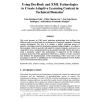239 search results - page 8 / 48 » A unified constraint model for XML |
NECO
1998
13 years 7 months ago
1998
three different levels of abstraction: detailed models including ctivity dynamics, weight dynamics that abstract from the neural activity dynamics by an adiabatic approximation, an...
ADBIS
2000
Springer
13 years 11 months ago
2000
Springer
In this paper we describe an approach to representation of data and knowledge using two technologies: XML and regular expressions in a domain of natural language syntactic analysis...
IJCSA
2006
13 years 7 months ago
2006
This work presents an XML-based authoring methodology that facilitates the different tasks associated with the development of standards-compliant e-learning content development. T...
FOIKS
2010
Springer
13 years 10 months ago
2010
Springer
Armstrong databases are a popular tool in example-based database design. An Armstrong database for a given constraint set from a fixed constraint class Z satisfies precisely those ...
WWW
2005
ACM
14 years 8 months ago
2005
ACM
A software design is often modeled as a collection of unified Modeling Language (UML) diagrams. There are different aspects of the software system that are covered by many differe...


